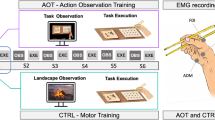Abstract
This study was designed to examine the generality of motor learning by action-observation. During practice, action-observation participants watched a learning model (e.g., physical practice participants) perform a motor sequence-timing task involving mouse/cursor movements on a computer screen; control participants watched a blank screen. Participants transferred to either a congruent (same mouse-cursor gain), or an incongruent (different mouse-cursor gain) condition. As predicted, motor sequence timing was learned through action-observation as well as physical practice. Moreover, transfer of learning to an incongruent set of task demands indicates that the motor representation developed through observation includes generalised visual-motor procedures associated with the use of feedback utilization.



Similar content being viewed by others
References
Adams JR (1986) The use of model’s knowledge of results to increase observer’s performance. J Hum Mov Stud 12:89–98
Aziz-Zadeh L, Maeda F, Zaidel E, Mazziotta J, Iacoboni M (2002) Lateralisation in motor facilitation during action-observation: a TMS study. Exp Brain Res 144:127–131
Badets A, Blandin Y, Shea CH (2006a) Intention in motor learning through observation. Q J Exp Psychol 59:377–386
Badets A, Blandin Y, Wright DL, Shea CH (2006b) Error detection processes in observational learning. Res Q Exerc Sport 77:177–184
Bird G, Heyes C (2005) Effector-dependent learning by observation of a finger movement sequence. J Exp Psychol Hum Percept Perform 31:262–275
Braden H, Panzer S, Shea CH (2008) The effects of sequence difficulty and practice on proportional and non-proportional transfer. Q J Exp Psychol 61:1321–1339
Brown LE, Wilson TE, Gribble PL (2009) Repetitive transcranial magnetic stimulation to primary motor cortex interferes with motor learning by observing. J Cogn Neurosci 21:1013–1022
Buccino G, Vogt S, Ritzi A, Fink GR, Zilles K, Freund HJ, Rizzolatti G (2004) Neural circuits underlying imitation learning of hand actions: an event-related fMRI study. Neuron 42:323–334
Cross ES, Kraemer DJM, Hamilton AFD, Kelly WM, Grafton ST (2009) Sensitivity to the action observation network to physical and observational learning. Cereb Cortex 19:315–326
Dean NJ, Kovacs AJ, Shea CH (2008) Transfer of movement sequences: bigger is better. Acta Psychol 127:355–368
Elliott D, Lyons J, Dyson K (1997) Rescaling an acquired discrete aiming movement: specific or general learning? Hum Mov Sci 16:81–96
Elliott D, Chua R, Helsen WF (2001) A century later: Woodworth’s (1899) two-component model of goal-directed aiming. Psychol Bull 127:342–357
Fadiga L, Fogassi L, Pavesi G, Rizzolatti G (1995) Motor facilitation during action observation: a magnetic study. J Neurophysiol 73:2608–2611
Hayes SJ, Timmis MA, Bennett SJ (2009) Eye movements are not a prerequisite for learning motor sequence timing through observation. Acta Psychol 131:202–208
Jeannerod M (1999) To act or not to act. Perspectives on the representation of actions. Q J Exp Psychol 52A:1–29
Mattar AAG, Gribble PL (2005) Motor learning by observing. Neuron 46:153–160
Osman M, Bird G, Heyes C (2005) Action observation supports effector dependent learning of finger movement sequence. Exp Brain Res 165:19–27
Schmidt RA (1975) A schema theory of discrete motor skill learning. Psychol Rev 82:225–260
Torriero S, Oliveri M, Koch G, Caltagirone C, Petrosini L (2007) The what and how of observational learning. J Cogn Neurosci 19:1656–1663
Vogt S (1995) On relations between perceiving, imagining and performing in learning of cyclical movement sequences. Br J Sport Psychol 86:191–216
Whiting HTA, Savelsbergh GJP, Pijpers JR (1995) Specificity of motor Learning does not deny flexibility. Appl Psychol 44:315–332
Wolpert DM, Flanagan JR (2001) Motor prediction. Curr Biol 11:R729–R732
Wolpert DM, Miall RC, Kawato M (1998) Internal models in the cerebellum. Trends Cogn Sci 2:338–347
Author information
Authors and Affiliations
Corresponding author
Rights and permissions
About this article
Cite this article
Hayes, S.J., Elliott, D. & Bennett, S.J. General motor representations are developed during action-observation. Exp Brain Res 204, 199–206 (2010). https://doi.org/10.1007/s00221-010-2303-6
Received:
Accepted:
Published:
Issue Date:
DOI: https://doi.org/10.1007/s00221-010-2303-6




